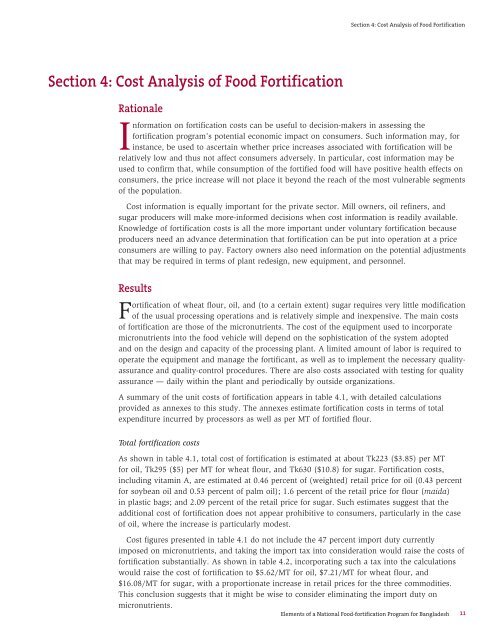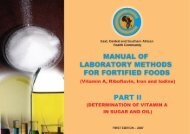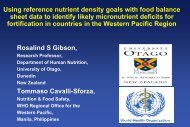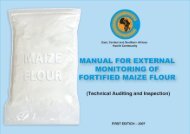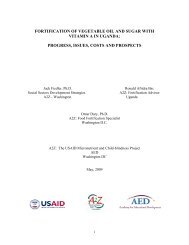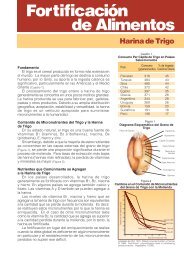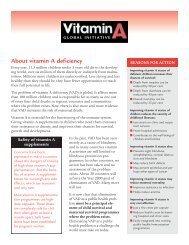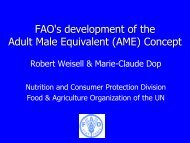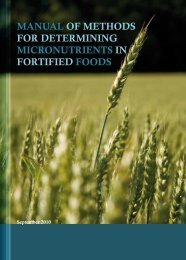Elements of a National Food- Fortification Program for Bangladesh
Elements of a National Food- Fortification Program for Bangladesh
Elements of a National Food- Fortification Program for Bangladesh
You also want an ePaper? Increase the reach of your titles
YUMPU automatically turns print PDFs into web optimized ePapers that Google loves.
Section 4: Cost Analysis <strong>of</strong> <strong>Food</strong> <strong>Fortification</strong>Section 4: Cost Analysis <strong>of</strong> <strong>Food</strong> <strong>Fortification</strong>RationaleIn<strong>for</strong>mation on <strong>for</strong>tification costs can be useful to decision-makers in assessing the<strong>for</strong>tification program’s potential economic impact on consumers. Such in<strong>for</strong>mation may, <strong>for</strong>instance, be used to ascertain whether price increases associated with <strong>for</strong>tification will berelatively low and thus not affect consumers adversely. In particular, cost in<strong>for</strong>mation may beused to confirm that, while consumption <strong>of</strong> the <strong>for</strong>tified food will have positive health effects onconsumers, the price increase will not place it beyond the reach <strong>of</strong> the most vulnerable segments<strong>of</strong> the population.Cost in<strong>for</strong>mation is equally important <strong>for</strong> the private sector. Mill owners, oil refiners, andsugar producers will make more-in<strong>for</strong>med decisions when cost in<strong>for</strong>mation is readily available.Knowledge <strong>of</strong> <strong>for</strong>tification costs is all the more important under voluntary <strong>for</strong>tification becauseproducers need an advance determination that <strong>for</strong>tification can be put into operation at a priceconsumers are willing to pay. Factory owners also need in<strong>for</strong>mation on the potential adjustmentsthat may be required in terms <strong>of</strong> plant redesign, new equipment, and personnel.Results<strong>Fortification</strong> <strong>of</strong> wheat flour, oil, and (to a certain extent) sugar requires very little modification<strong>of</strong> the usual processing operations and is relatively simple and inexpensive. The main costs<strong>of</strong> <strong>for</strong>tification are those <strong>of</strong> the micronutrients. The cost <strong>of</strong> the equipment used to incorporatemicronutrients into the food vehicle will depend on the sophistication <strong>of</strong> the system adoptedand on the design and capacity <strong>of</strong> the processing plant. A limited amount <strong>of</strong> labor is required tooperate the equipment and manage the <strong>for</strong>tificant, as well as to implement the necessary qualityassuranceand quality-control procedures. There are also costs associated with testing <strong>for</strong> qualityassurance — daily within the plant and periodically by outside organizations.A summary <strong>of</strong> the unit costs <strong>of</strong> <strong>for</strong>tification appears in table 4.1, with detailed calculationsprovided as annexes to this study. The annexes estimate <strong>for</strong>tification costs in terms <strong>of</strong> totalexpenditure incurred by processors as well as per MT <strong>of</strong> <strong>for</strong>tified flour.Total <strong>for</strong>tification costsAs shown in table 4.1, total cost <strong>of</strong> <strong>for</strong>tification is estimated at about Tk223 ($3.85) per MT<strong>for</strong> oil, Tk295 ($5) per MT <strong>for</strong> wheat flour, and Tk630 ($10.8) <strong>for</strong> sugar. <strong>Fortification</strong> costs,including vitamin A, are estimated at 0.46 percent <strong>of</strong> (weighted) retail price <strong>for</strong> oil (0.43 percent<strong>for</strong> soybean oil and 0.53 percent <strong>of</strong> palm oil); 1.6 percent <strong>of</strong> the retail price <strong>for</strong> flour (maida)in plastic bags; and 2.09 percent <strong>of</strong> the retail price <strong>for</strong> sugar. Such estimates suggest that theadditional cost <strong>of</strong> <strong>for</strong>tification does not appear prohibitive to consumers, particularly in the case<strong>of</strong> oil, where the increase is particularly modest.Cost figures presented in table 4.1 do not include the 47 percent import duty currentlyimposed on micronutrients, and taking the import tax into consideration would raise the costs <strong>of</strong><strong>for</strong>tification substantially. As shown in table 4.2, incorporating such a tax into the calculationswould raise the cost <strong>of</strong> <strong>for</strong>tification to $5.62/MT <strong>for</strong> oil, $7.21/MT <strong>for</strong> wheat flour, and$16.08/MT <strong>for</strong> sugar, with a proportionate increase in retail prices <strong>for</strong> the three commodities.This conclusion suggests that it might be wise to consider eliminating the import duty onmicronutrients.<strong>Elements</strong> <strong>of</strong> a <strong>National</strong> <strong>Food</strong>-<strong>for</strong>tification <strong>Program</strong> <strong>for</strong> <strong>Bangladesh</strong>11


